Analysis of Qualitative Changes in the Global Economy (MN2166K)
VerifiedAdded on 2022/12/29
|10
|2217
|23
Report
AI Summary
This report provides a comprehensive analysis of the qualitative changes that have reshaped the global economy over the past six decades. It begins by defining globalization and differentiating it from related concepts like internationalization and westernization, drawing heavily on the work of Peter Dicken. The report then explores key transformations, including technological advancements in finance, communication, and transportation, leading to the shrinkage of time and cost in doing business. It also examines the increasing volatility in global economic growth, the interconnectedness of trade activities, and the rise of foreign direct investments. Furthermore, the report highlights the growing need for international trade regulation, the evolving political landscapes, changes in consumer preferences, and the implementation of efficient environmental practices. The analysis emphasizes the impact of these changes on various industries and economies, concluding that the current economic, financial, and political scenarios are products of these interconnected developments.

ECONOMICS
THE GLOBAL ECONOMY
THE GLOBAL ECONOMY
Paraphrase This Document
Need a fresh take? Get an instant paraphrase of this document with our AI Paraphraser
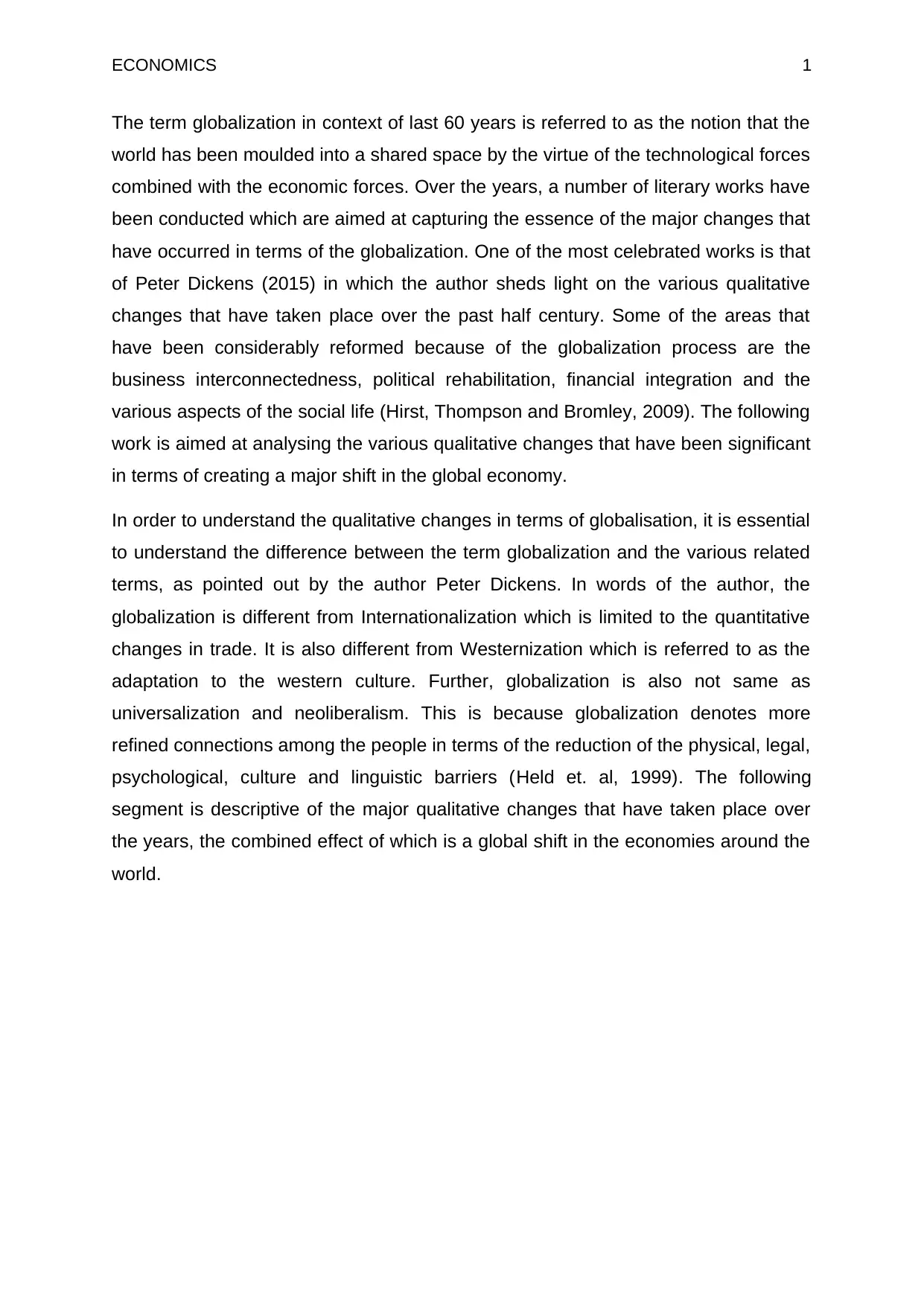
ECONOMICS 1
The term globalization in context of last 60 years is referred to as the notion that the
world has been moulded into a shared space by the virtue of the technological forces
combined with the economic forces. Over the years, a number of literary works have
been conducted which are aimed at capturing the essence of the major changes that
have occurred in terms of the globalization. One of the most celebrated works is that
of Peter Dickens (2015) in which the author sheds light on the various qualitative
changes that have taken place over the past half century. Some of the areas that
have been considerably reformed because of the globalization process are the
business interconnectedness, political rehabilitation, financial integration and the
various aspects of the social life (Hirst, Thompson and Bromley, 2009). The following
work is aimed at analysing the various qualitative changes that have been significant
in terms of creating a major shift in the global economy.
In order to understand the qualitative changes in terms of globalisation, it is essential
to understand the difference between the term globalization and the various related
terms, as pointed out by the author Peter Dickens. In words of the author, the
globalization is different from Internationalization which is limited to the quantitative
changes in trade. It is also different from Westernization which is referred to as the
adaptation to the western culture. Further, globalization is also not same as
universalization and neoliberalism. This is because globalization denotes more
refined connections among the people in terms of the reduction of the physical, legal,
psychological, culture and linguistic barriers (Held et. al, 1999). The following
segment is descriptive of the major qualitative changes that have taken place over
the years, the combined effect of which is a global shift in the economies around the
world.
The term globalization in context of last 60 years is referred to as the notion that the
world has been moulded into a shared space by the virtue of the technological forces
combined with the economic forces. Over the years, a number of literary works have
been conducted which are aimed at capturing the essence of the major changes that
have occurred in terms of the globalization. One of the most celebrated works is that
of Peter Dickens (2015) in which the author sheds light on the various qualitative
changes that have taken place over the past half century. Some of the areas that
have been considerably reformed because of the globalization process are the
business interconnectedness, political rehabilitation, financial integration and the
various aspects of the social life (Hirst, Thompson and Bromley, 2009). The following
work is aimed at analysing the various qualitative changes that have been significant
in terms of creating a major shift in the global economy.
In order to understand the qualitative changes in terms of globalisation, it is essential
to understand the difference between the term globalization and the various related
terms, as pointed out by the author Peter Dickens. In words of the author, the
globalization is different from Internationalization which is limited to the quantitative
changes in trade. It is also different from Westernization which is referred to as the
adaptation to the western culture. Further, globalization is also not same as
universalization and neoliberalism. This is because globalization denotes more
refined connections among the people in terms of the reduction of the physical, legal,
psychological, culture and linguistic barriers (Held et. al, 1999). The following
segment is descriptive of the major qualitative changes that have taken place over
the years, the combined effect of which is a global shift in the economies around the
world.
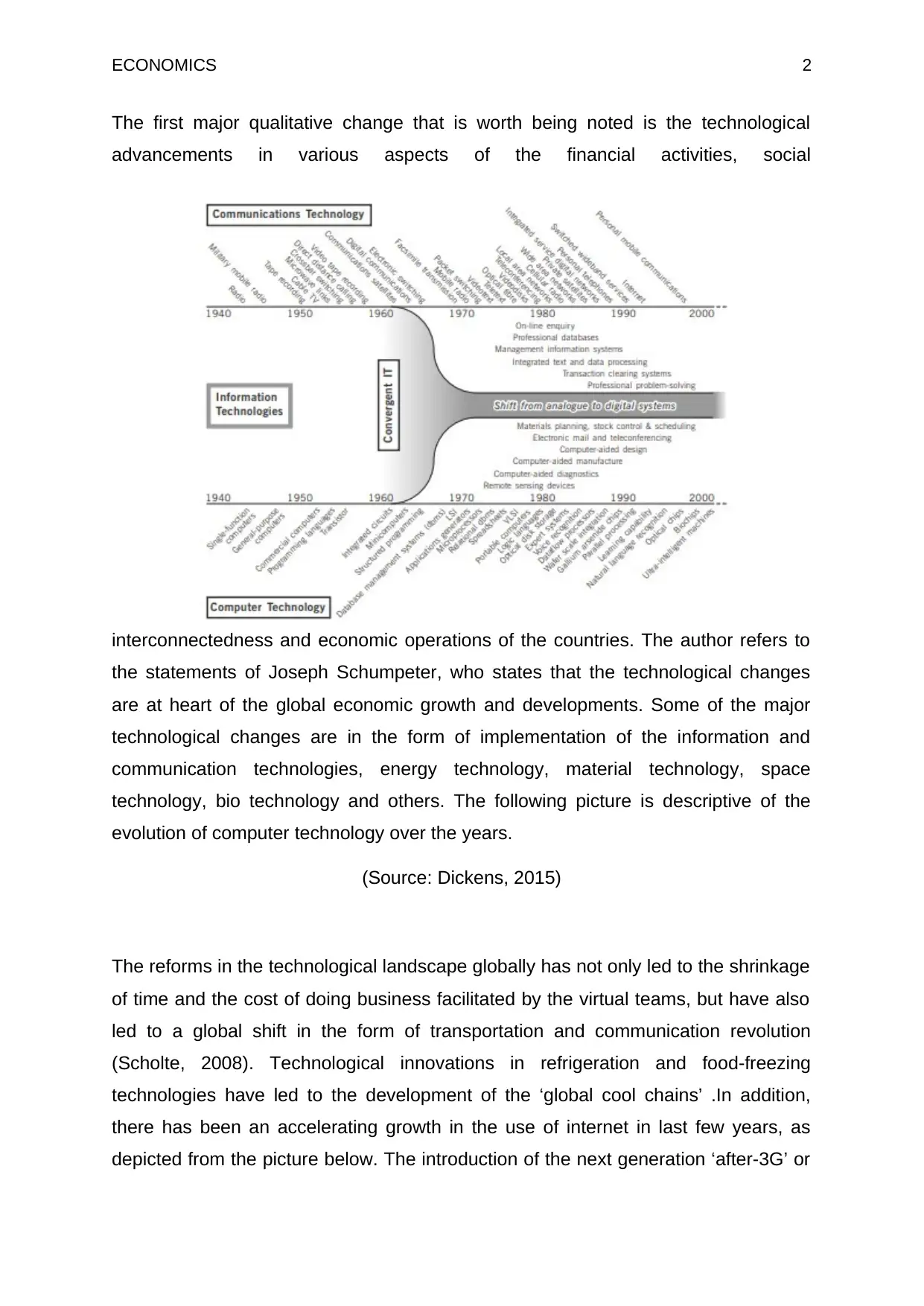
ECONOMICS 2
The first major qualitative change that is worth being noted is the technological
advancements in various aspects of the financial activities, social
interconnectedness and economic operations of the countries. The author refers to
the statements of Joseph Schumpeter, who states that the technological changes
are at heart of the global economic growth and developments. Some of the major
technological changes are in the form of implementation of the information and
communication technologies, energy technology, material technology, space
technology, bio technology and others. The following picture is descriptive of the
evolution of computer technology over the years.
(Source: Dickens, 2015)
The reforms in the technological landscape globally has not only led to the shrinkage
of time and the cost of doing business facilitated by the virtual teams, but have also
led to a global shift in the form of transportation and communication revolution
(Scholte, 2008). Technological innovations in refrigeration and food-freezing
technologies have led to the development of the ‘global cool chains’ .In addition,
there has been an accelerating growth in the use of internet in last few years, as
depicted from the picture below. The introduction of the next generation ‘after-3G’ or
The first major qualitative change that is worth being noted is the technological
advancements in various aspects of the financial activities, social
interconnectedness and economic operations of the countries. The author refers to
the statements of Joseph Schumpeter, who states that the technological changes
are at heart of the global economic growth and developments. Some of the major
technological changes are in the form of implementation of the information and
communication technologies, energy technology, material technology, space
technology, bio technology and others. The following picture is descriptive of the
evolution of computer technology over the years.
(Source: Dickens, 2015)
The reforms in the technological landscape globally has not only led to the shrinkage
of time and the cost of doing business facilitated by the virtual teams, but have also
led to a global shift in the form of transportation and communication revolution
(Scholte, 2008). Technological innovations in refrigeration and food-freezing
technologies have led to the development of the ‘global cool chains’ .In addition,
there has been an accelerating growth in the use of internet in last few years, as
depicted from the picture below. The introduction of the next generation ‘after-3G’ or
⊘ This is a preview!⊘
Do you want full access?
Subscribe today to unlock all pages.

Trusted by 1+ million students worldwide
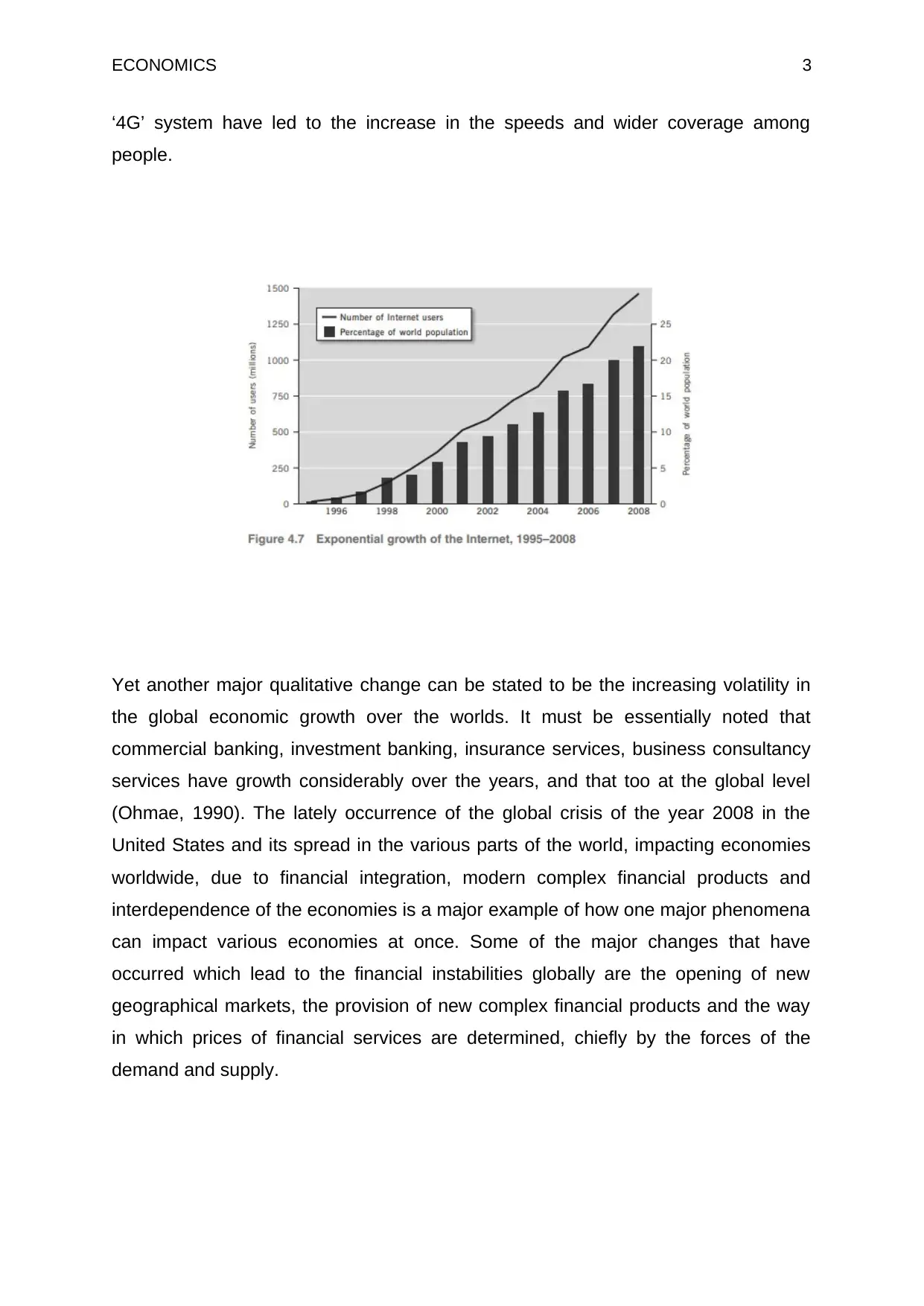
ECONOMICS 3
‘4G’ system have led to the increase in the speeds and wider coverage among
people.
Yet another major qualitative change can be stated to be the increasing volatility in
the global economic growth over the worlds. It must be essentially noted that
commercial banking, investment banking, insurance services, business consultancy
services have growth considerably over the years, and that too at the global level
(Ohmae, 1990). The lately occurrence of the global crisis of the year 2008 in the
United States and its spread in the various parts of the world, impacting economies
worldwide, due to financial integration, modern complex financial products and
interdependence of the economies is a major example of how one major phenomena
can impact various economies at once. Some of the major changes that have
occurred which lead to the financial instabilities globally are the opening of new
geographical markets, the provision of new complex financial products and the way
in which prices of financial services are determined, chiefly by the forces of the
demand and supply.
‘4G’ system have led to the increase in the speeds and wider coverage among
people.
Yet another major qualitative change can be stated to be the increasing volatility in
the global economic growth over the worlds. It must be essentially noted that
commercial banking, investment banking, insurance services, business consultancy
services have growth considerably over the years, and that too at the global level
(Ohmae, 1990). The lately occurrence of the global crisis of the year 2008 in the
United States and its spread in the various parts of the world, impacting economies
worldwide, due to financial integration, modern complex financial products and
interdependence of the economies is a major example of how one major phenomena
can impact various economies at once. Some of the major changes that have
occurred which lead to the financial instabilities globally are the opening of new
geographical markets, the provision of new complex financial products and the way
in which prices of financial services are determined, chiefly by the forces of the
demand and supply.
Paraphrase This Document
Need a fresh take? Get an instant paraphrase of this document with our AI Paraphraser
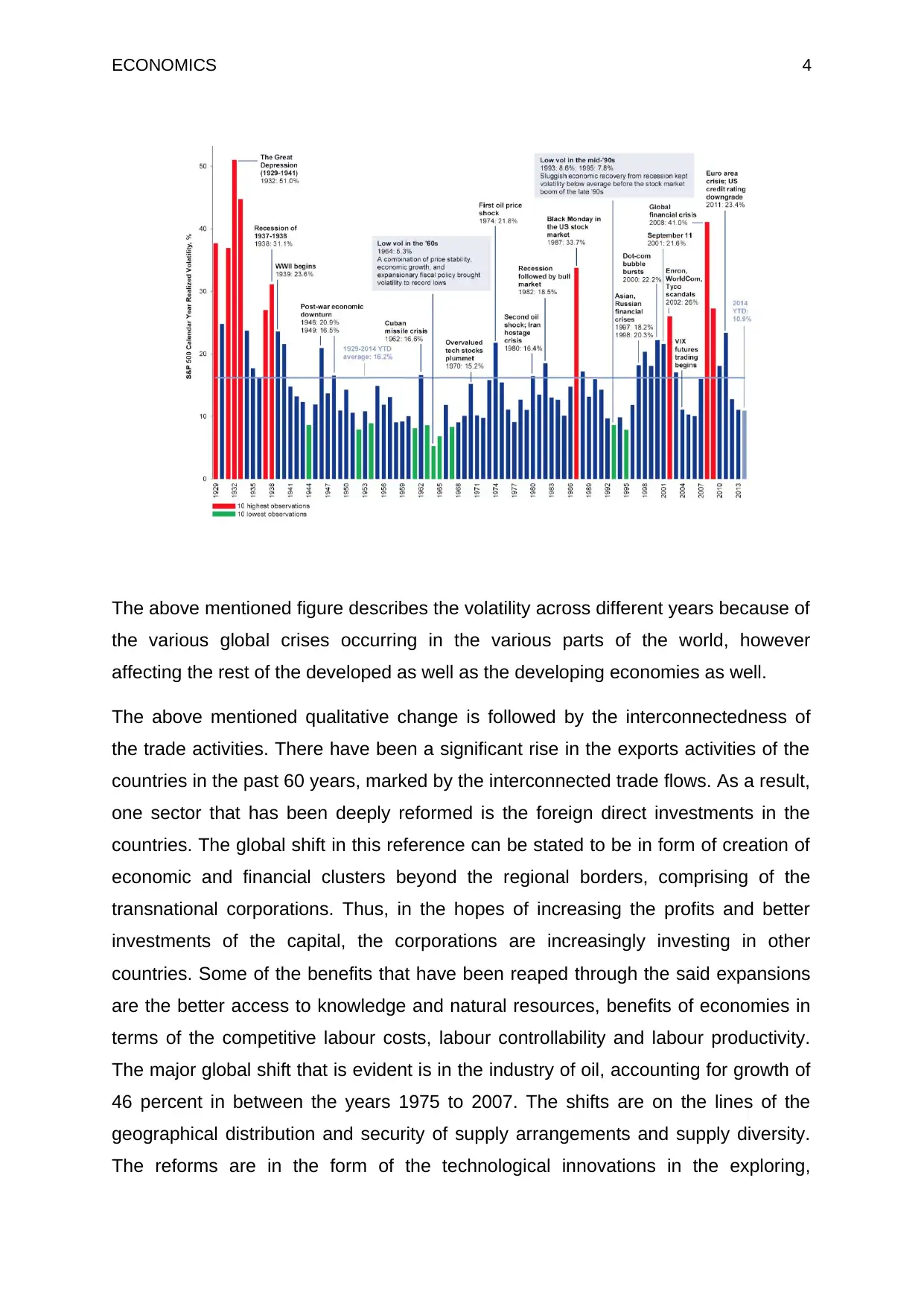
ECONOMICS 4
The above mentioned figure describes the volatility across different years because of
the various global crises occurring in the various parts of the world, however
affecting the rest of the developed as well as the developing economies as well.
The above mentioned qualitative change is followed by the interconnectedness of
the trade activities. There have been a significant rise in the exports activities of the
countries in the past 60 years, marked by the interconnected trade flows. As a result,
one sector that has been deeply reformed is the foreign direct investments in the
countries. The global shift in this reference can be stated to be in form of creation of
economic and financial clusters beyond the regional borders, comprising of the
transnational corporations. Thus, in the hopes of increasing the profits and better
investments of the capital, the corporations are increasingly investing in other
countries. Some of the benefits that have been reaped through the said expansions
are the better access to knowledge and natural resources, benefits of economies in
terms of the competitive labour costs, labour controllability and labour productivity.
The major global shift that is evident is in the industry of oil, accounting for growth of
46 percent in between the years 1975 to 2007. The shifts are on the lines of the
geographical distribution and security of supply arrangements and supply diversity.
The reforms are in the form of the technological innovations in the exploring,
The above mentioned figure describes the volatility across different years because of
the various global crises occurring in the various parts of the world, however
affecting the rest of the developed as well as the developing economies as well.
The above mentioned qualitative change is followed by the interconnectedness of
the trade activities. There have been a significant rise in the exports activities of the
countries in the past 60 years, marked by the interconnected trade flows. As a result,
one sector that has been deeply reformed is the foreign direct investments in the
countries. The global shift in this reference can be stated to be in form of creation of
economic and financial clusters beyond the regional borders, comprising of the
transnational corporations. Thus, in the hopes of increasing the profits and better
investments of the capital, the corporations are increasingly investing in other
countries. Some of the benefits that have been reaped through the said expansions
are the better access to knowledge and natural resources, benefits of economies in
terms of the competitive labour costs, labour controllability and labour productivity.
The major global shift that is evident is in the industry of oil, accounting for growth of
46 percent in between the years 1975 to 2007. The shifts are on the lines of the
geographical distribution and security of supply arrangements and supply diversity.
The reforms are in the form of the technological innovations in the exploring,
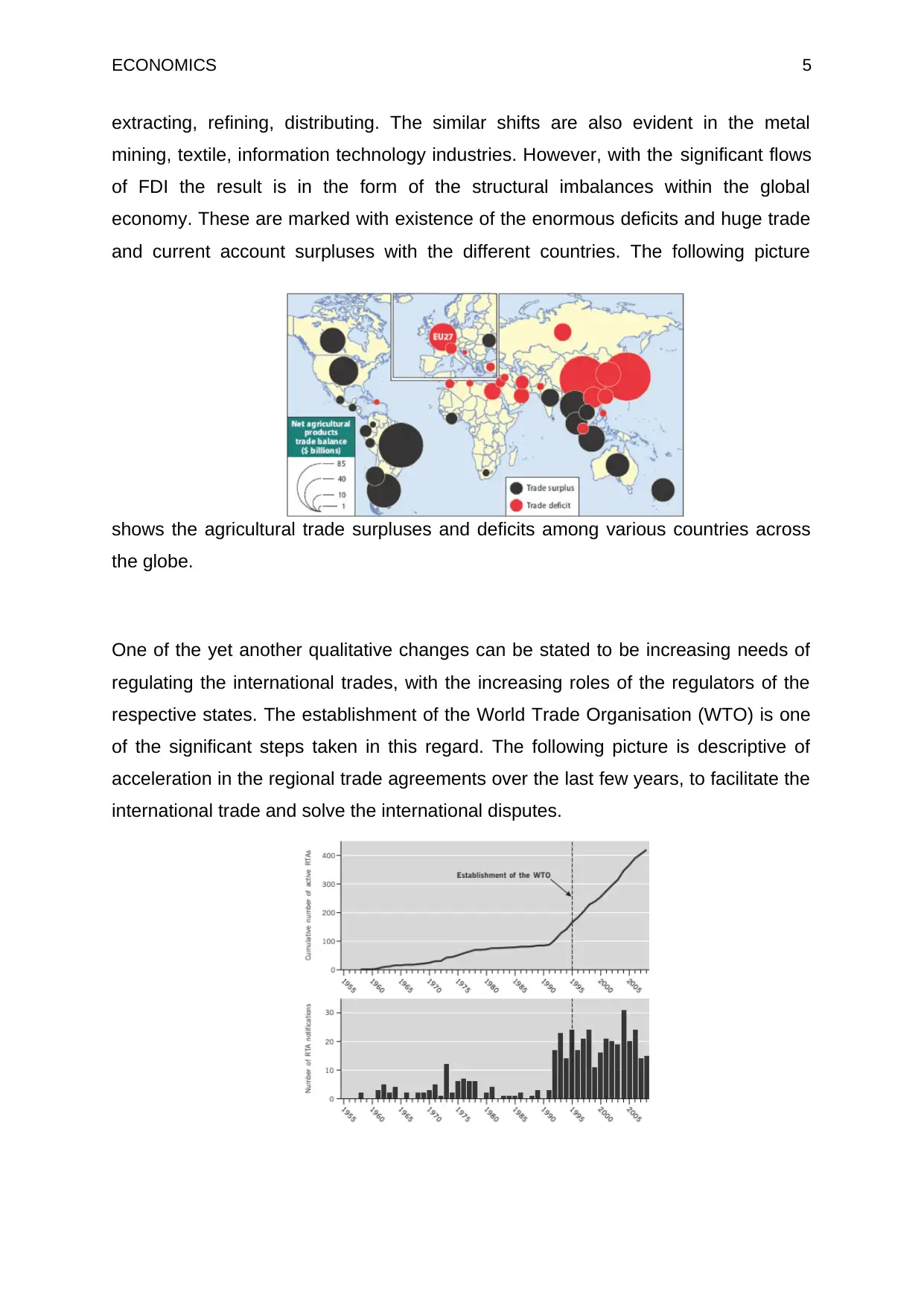
ECONOMICS 5
extracting, refining, distributing. The similar shifts are also evident in the metal
mining, textile, information technology industries. However, with the significant flows
of FDI the result is in the form of the structural imbalances within the global
economy. These are marked with existence of the enormous deficits and huge trade
and current account surpluses with the different countries. The following picture
shows the agricultural trade surpluses and deficits among various countries across
the globe.
One of the yet another qualitative changes can be stated to be increasing needs of
regulating the international trades, with the increasing roles of the regulators of the
respective states. The establishment of the World Trade Organisation (WTO) is one
of the significant steps taken in this regard. The following picture is descriptive of
acceleration in the regional trade agreements over the last few years, to facilitate the
international trade and solve the international disputes.
extracting, refining, distributing. The similar shifts are also evident in the metal
mining, textile, information technology industries. However, with the significant flows
of FDI the result is in the form of the structural imbalances within the global
economy. These are marked with existence of the enormous deficits and huge trade
and current account surpluses with the different countries. The following picture
shows the agricultural trade surpluses and deficits among various countries across
the globe.
One of the yet another qualitative changes can be stated to be increasing needs of
regulating the international trades, with the increasing roles of the regulators of the
respective states. The establishment of the World Trade Organisation (WTO) is one
of the significant steps taken in this regard. The following picture is descriptive of
acceleration in the regional trade agreements over the last few years, to facilitate the
international trade and solve the international disputes.
⊘ This is a preview!⊘
Do you want full access?
Subscribe today to unlock all pages.

Trusted by 1+ million students worldwide
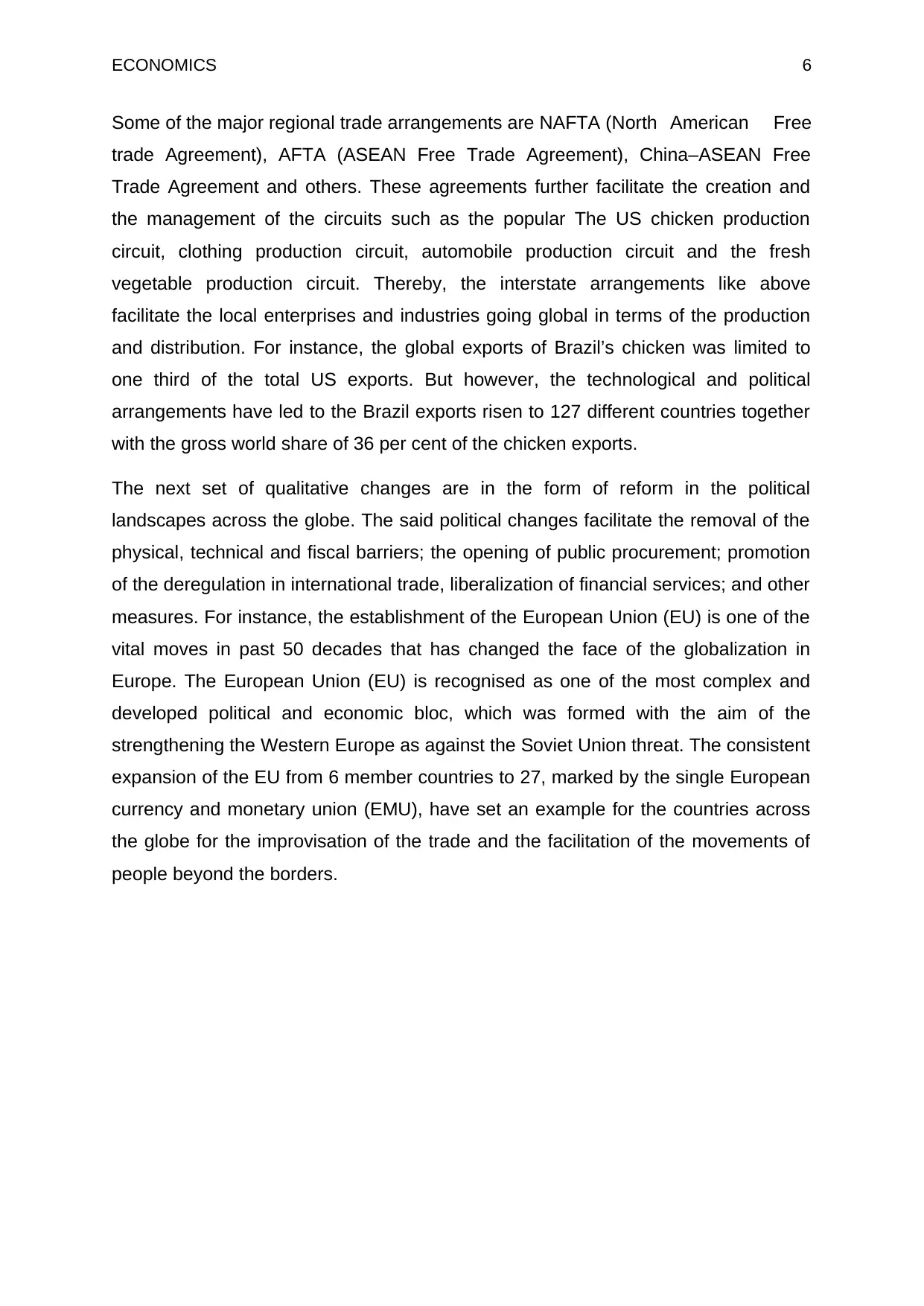
ECONOMICS 6
Some of the major regional trade arrangements are NAFTA (North American Free
trade Agreement), AFTA (ASEAN Free Trade Agreement), China–ASEAN Free
Trade Agreement and others. These agreements further facilitate the creation and
the management of the circuits such as the popular The US chicken production
circuit, clothing production circuit, automobile production circuit and the fresh
vegetable production circuit. Thereby, the interstate arrangements like above
facilitate the local enterprises and industries going global in terms of the production
and distribution. For instance, the global exports of Brazil’s chicken was limited to
one third of the total US exports. But however, the technological and political
arrangements have led to the Brazil exports risen to 127 different countries together
with the gross world share of 36 per cent of the chicken exports.
The next set of qualitative changes are in the form of reform in the political
landscapes across the globe. The said political changes facilitate the removal of the
physical, technical and fiscal barriers; the opening of public procurement; promotion
of the deregulation in international trade, liberalization of financial services; and other
measures. For instance, the establishment of the European Union (EU) is one of the
vital moves in past 50 decades that has changed the face of the globalization in
Europe. The European Union (EU) is recognised as one of the most complex and
developed political and economic bloc, which was formed with the aim of the
strengthening the Western Europe as against the Soviet Union threat. The consistent
expansion of the EU from 6 member countries to 27, marked by the single European
currency and monetary union (EMU), have set an example for the countries across
the globe for the improvisation of the trade and the facilitation of the movements of
people beyond the borders.
Some of the major regional trade arrangements are NAFTA (North American Free
trade Agreement), AFTA (ASEAN Free Trade Agreement), China–ASEAN Free
Trade Agreement and others. These agreements further facilitate the creation and
the management of the circuits such as the popular The US chicken production
circuit, clothing production circuit, automobile production circuit and the fresh
vegetable production circuit. Thereby, the interstate arrangements like above
facilitate the local enterprises and industries going global in terms of the production
and distribution. For instance, the global exports of Brazil’s chicken was limited to
one third of the total US exports. But however, the technological and political
arrangements have led to the Brazil exports risen to 127 different countries together
with the gross world share of 36 per cent of the chicken exports.
The next set of qualitative changes are in the form of reform in the political
landscapes across the globe. The said political changes facilitate the removal of the
physical, technical and fiscal barriers; the opening of public procurement; promotion
of the deregulation in international trade, liberalization of financial services; and other
measures. For instance, the establishment of the European Union (EU) is one of the
vital moves in past 50 decades that has changed the face of the globalization in
Europe. The European Union (EU) is recognised as one of the most complex and
developed political and economic bloc, which was formed with the aim of the
strengthening the Western Europe as against the Soviet Union threat. The consistent
expansion of the EU from 6 member countries to 27, marked by the single European
currency and monetary union (EMU), have set an example for the countries across
the globe for the improvisation of the trade and the facilitation of the movements of
people beyond the borders.
Paraphrase This Document
Need a fresh take? Get an instant paraphrase of this document with our AI Paraphraser
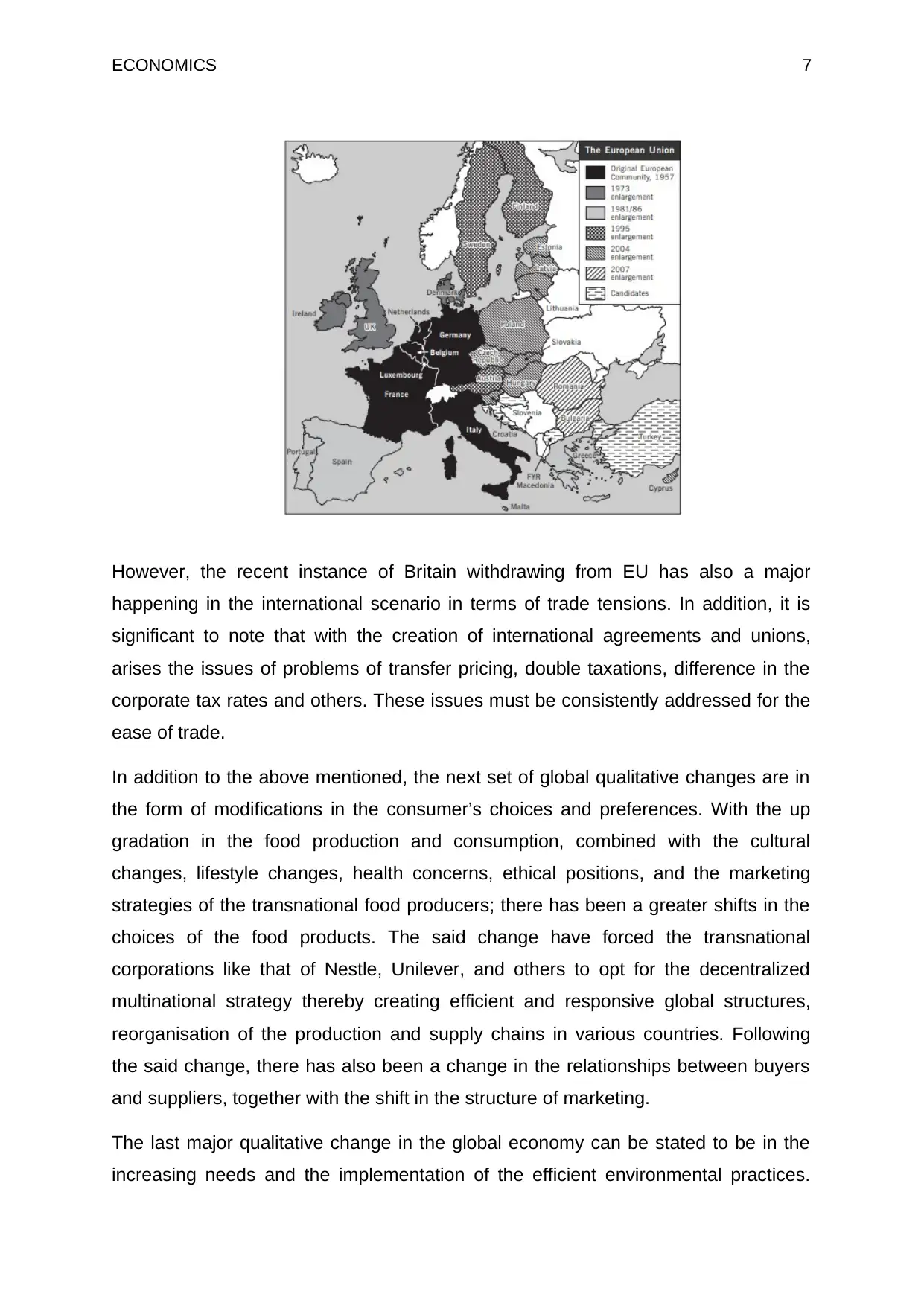
ECONOMICS 7
However, the recent instance of Britain withdrawing from EU has also a major
happening in the international scenario in terms of trade tensions. In addition, it is
significant to note that with the creation of international agreements and unions,
arises the issues of problems of transfer pricing, double taxations, difference in the
corporate tax rates and others. These issues must be consistently addressed for the
ease of trade.
In addition to the above mentioned, the next set of global qualitative changes are in
the form of modifications in the consumer’s choices and preferences. With the up
gradation in the food production and consumption, combined with the cultural
changes, lifestyle changes, health concerns, ethical positions, and the marketing
strategies of the transnational food producers; there has been a greater shifts in the
choices of the food products. The said change have forced the transnational
corporations like that of Nestle, Unilever, and others to opt for the decentralized
multinational strategy thereby creating efficient and responsive global structures,
reorganisation of the production and supply chains in various countries. Following
the said change, there has also been a change in the relationships between buyers
and suppliers, together with the shift in the structure of marketing.
The last major qualitative change in the global economy can be stated to be in the
increasing needs and the implementation of the efficient environmental practices.
However, the recent instance of Britain withdrawing from EU has also a major
happening in the international scenario in terms of trade tensions. In addition, it is
significant to note that with the creation of international agreements and unions,
arises the issues of problems of transfer pricing, double taxations, difference in the
corporate tax rates and others. These issues must be consistently addressed for the
ease of trade.
In addition to the above mentioned, the next set of global qualitative changes are in
the form of modifications in the consumer’s choices and preferences. With the up
gradation in the food production and consumption, combined with the cultural
changes, lifestyle changes, health concerns, ethical positions, and the marketing
strategies of the transnational food producers; there has been a greater shifts in the
choices of the food products. The said change have forced the transnational
corporations like that of Nestle, Unilever, and others to opt for the decentralized
multinational strategy thereby creating efficient and responsive global structures,
reorganisation of the production and supply chains in various countries. Following
the said change, there has also been a change in the relationships between buyers
and suppliers, together with the shift in the structure of marketing.
The last major qualitative change in the global economy can be stated to be in the
increasing needs and the implementation of the efficient environmental practices.
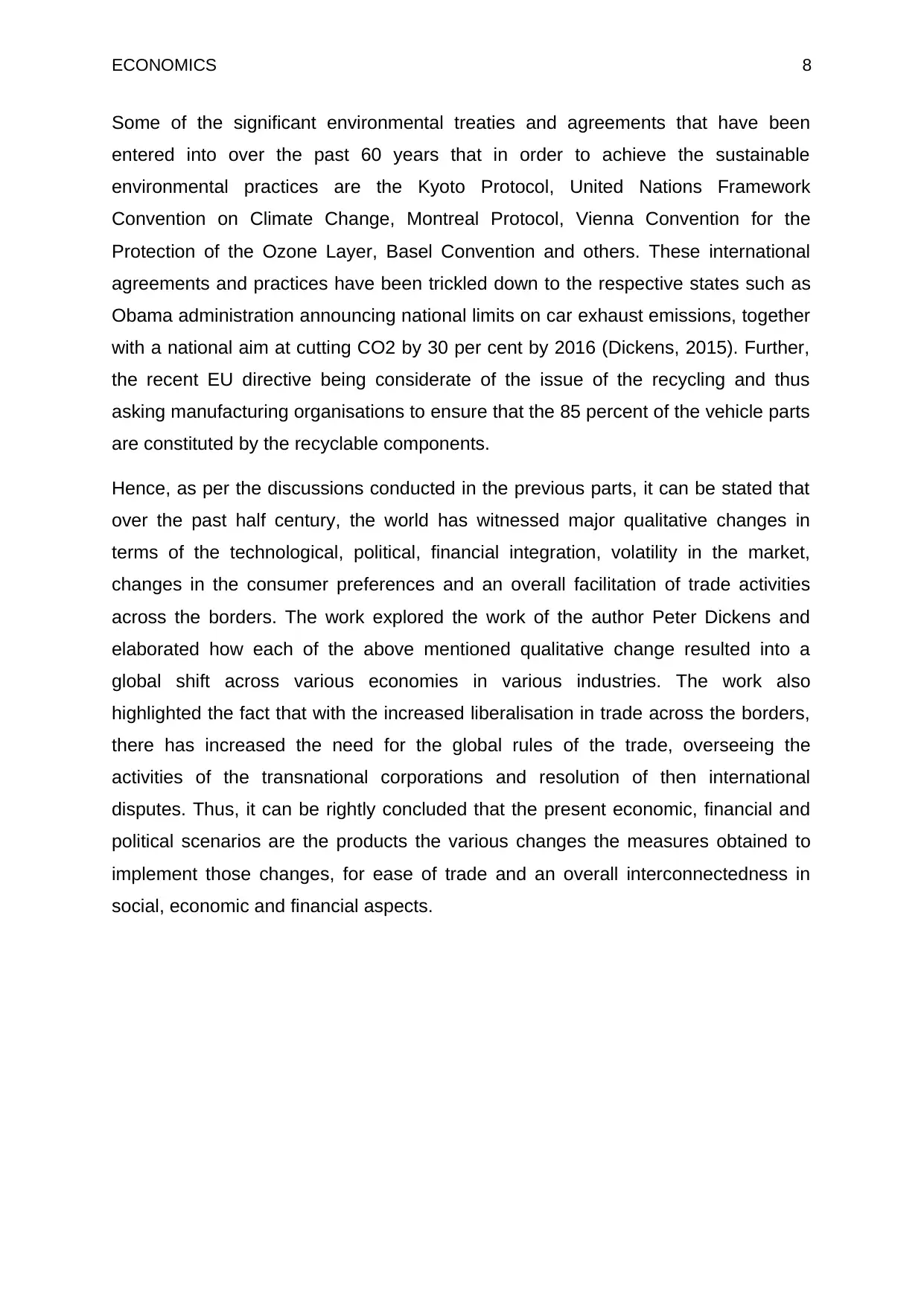
ECONOMICS 8
Some of the significant environmental treaties and agreements that have been
entered into over the past 60 years that in order to achieve the sustainable
environmental practices are the Kyoto Protocol, United Nations Framework
Convention on Climate Change, Montreal Protocol, Vienna Convention for the
Protection of the Ozone Layer, Basel Convention and others. These international
agreements and practices have been trickled down to the respective states such as
Obama administration announcing national limits on car exhaust emissions, together
with a national aim at cutting CO2 by 30 per cent by 2016 (Dickens, 2015). Further,
the recent EU directive being considerate of the issue of the recycling and thus
asking manufacturing organisations to ensure that the 85 percent of the vehicle parts
are constituted by the recyclable components.
Hence, as per the discussions conducted in the previous parts, it can be stated that
over the past half century, the world has witnessed major qualitative changes in
terms of the technological, political, financial integration, volatility in the market,
changes in the consumer preferences and an overall facilitation of trade activities
across the borders. The work explored the work of the author Peter Dickens and
elaborated how each of the above mentioned qualitative change resulted into a
global shift across various economies in various industries. The work also
highlighted the fact that with the increased liberalisation in trade across the borders,
there has increased the need for the global rules of the trade, overseeing the
activities of the transnational corporations and resolution of then international
disputes. Thus, it can be rightly concluded that the present economic, financial and
political scenarios are the products the various changes the measures obtained to
implement those changes, for ease of trade and an overall interconnectedness in
social, economic and financial aspects.
Some of the significant environmental treaties and agreements that have been
entered into over the past 60 years that in order to achieve the sustainable
environmental practices are the Kyoto Protocol, United Nations Framework
Convention on Climate Change, Montreal Protocol, Vienna Convention for the
Protection of the Ozone Layer, Basel Convention and others. These international
agreements and practices have been trickled down to the respective states such as
Obama administration announcing national limits on car exhaust emissions, together
with a national aim at cutting CO2 by 30 per cent by 2016 (Dickens, 2015). Further,
the recent EU directive being considerate of the issue of the recycling and thus
asking manufacturing organisations to ensure that the 85 percent of the vehicle parts
are constituted by the recyclable components.
Hence, as per the discussions conducted in the previous parts, it can be stated that
over the past half century, the world has witnessed major qualitative changes in
terms of the technological, political, financial integration, volatility in the market,
changes in the consumer preferences and an overall facilitation of trade activities
across the borders. The work explored the work of the author Peter Dickens and
elaborated how each of the above mentioned qualitative change resulted into a
global shift across various economies in various industries. The work also
highlighted the fact that with the increased liberalisation in trade across the borders,
there has increased the need for the global rules of the trade, overseeing the
activities of the transnational corporations and resolution of then international
disputes. Thus, it can be rightly concluded that the present economic, financial and
political scenarios are the products the various changes the measures obtained to
implement those changes, for ease of trade and an overall interconnectedness in
social, economic and financial aspects.
⊘ This is a preview!⊘
Do you want full access?
Subscribe today to unlock all pages.

Trusted by 1+ million students worldwide
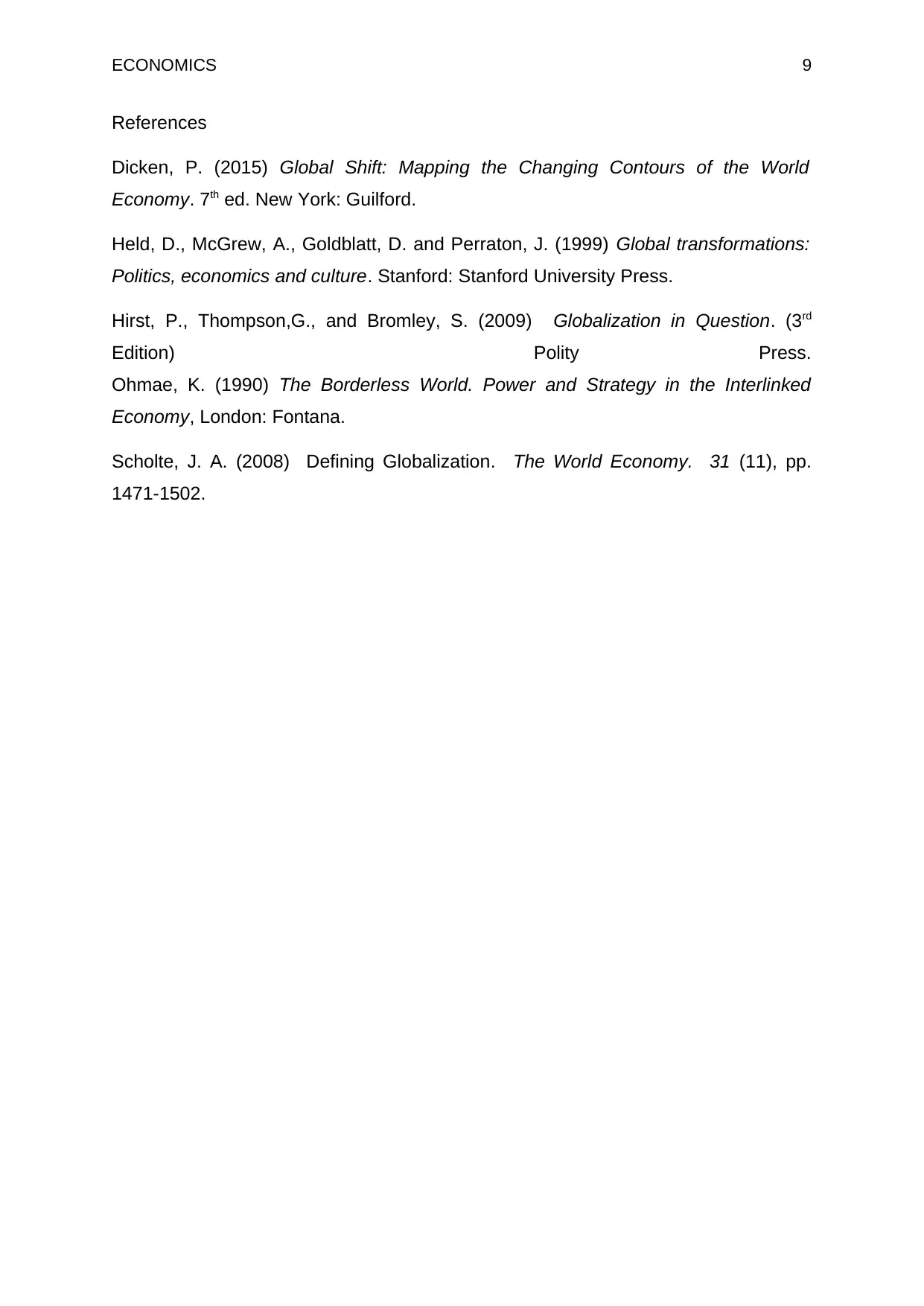
ECONOMICS 9
References
Dicken, P. (2015) Global Shift: Mapping the Changing Contours of the World
Economy. 7th ed. New York: Guilford.
Held, D., McGrew, A., Goldblatt, D. and Perraton, J. (1999) Global transformations:
Politics, economics and culture. Stanford: Stanford University Press.
Hirst, P., Thompson,G., and Bromley, S. (2009) Globalization in Question. (3rd
Edition) Polity Press.
Ohmae, K. (1990) The Borderless World. Power and Strategy in the Interlinked
Economy, London: Fontana.
Scholte, J. A. (2008) Defining Globalization. The World Economy. 31 (11), pp.
1471-1502.
References
Dicken, P. (2015) Global Shift: Mapping the Changing Contours of the World
Economy. 7th ed. New York: Guilford.
Held, D., McGrew, A., Goldblatt, D. and Perraton, J. (1999) Global transformations:
Politics, economics and culture. Stanford: Stanford University Press.
Hirst, P., Thompson,G., and Bromley, S. (2009) Globalization in Question. (3rd
Edition) Polity Press.
Ohmae, K. (1990) The Borderless World. Power and Strategy in the Interlinked
Economy, London: Fontana.
Scholte, J. A. (2008) Defining Globalization. The World Economy. 31 (11), pp.
1471-1502.
1 out of 10
Related Documents
Your All-in-One AI-Powered Toolkit for Academic Success.
+13062052269
info@desklib.com
Available 24*7 on WhatsApp / Email
![[object Object]](/_next/static/media/star-bottom.7253800d.svg)
Unlock your academic potential
Copyright © 2020–2025 A2Z Services. All Rights Reserved. Developed and managed by ZUCOL.





